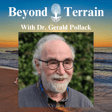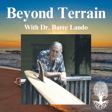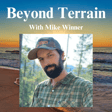Introduction and Guest Welcome
00:00:02
Speaker
Welcome everybody to another episode of the Beyond Drain podcast. I'm your host, Lee of Dalton. Today we're joined once again by another fantastic guest. So very grateful to have Dr. Marizel Arce on. Our last episode was fantastic. It's actually my mom's favorite episode. So she, yeah she absolutely loved it and she loved you and your energy and everything that you had to say. It was, and it was a fantastic episode. I really enjoyed listening back on it. So thank you so much for your time and thanks for coming on again today.
00:00:32
Speaker
Oh, my pleasure. I look forward to our conversation. so All right.
Introduction to Pleomorphism
00:00:38
Speaker
I got no introductory question for this one here. So last time we discussed health, um what that means. But today we're going to talk about pleomorphism. And this is a really integral part of the train movement. You know, it's something that is under emphasized in the modern understanding ah I'd love to hear maybe a little bit later about, you know, what the modern point of view is on it. But I think I just want to start with a little bit of an overview. I kind of want to give you the floor, tell us what pleomorphism is, what it's all about, what role does it play in health and disease. So I'll give you the floor and you can take it from there.
Historical Overview of Pleomorphism
00:01:16
Speaker
So, Pliomorphism around the early 1800s, Bachamp was the first Pierre Antoine Bachamp. He was has so many different titles and he was a professor and a doctor and a chemist. um He discovered that the organisms, the microbes that we call bacteria, fungus, etc.,
00:01:40
Speaker
They change shape. so he dead Back then it was pleomorph or polymorph. It was something that had multiple forms, morph meaning the shape. um And he discovered this because he discovered ah these what he called little granules, ah little colloids in the body, in the blood of animals and plants, by doing several different types of experiments, etc. And he discovered that they were always there. they're you know And they changed shape based on
00:02:15
Speaker
What's happening in the body so he didn't get to really see because of the equipment and technology that he had at the time he didn't get to see all the different various forms that these things that he delegated the name microzima to but he understood that within our bodies that we have these little proto protogranules or colloids or whatever you want to delegate them as, um that are maintaining our body, that we work, we are symbiotic with it, um and that they alter themselves according to their terrain. So from there, um several other scientists
Contributions of European Scientists
00:02:56
Speaker
um throughout Europe um discovered his work or was doing similar work alongside around the time when he kind of was kind of waning away in terms of his prestige and his research and things like that. um There was an Ernest Elmquist. He actually worked with Robert Koch, if everybody knows the Koch's postulates, right? So ah Ernest Elmquist actually had 21 years of research of studying pleomorphism.
00:03:32
Speaker
He was a little later on, so his microscopes, his technology was a little bit more advanced than Bashamt, and he was actually able to see, based on looking at one bacteria, for instance, he would put it in this this terrain or that terrain, and by terrain I mean environment, the the environment with which it thrived. So it would he would take some sort of bacteria, put it in one environment, change it, and put another environment, change that again, and he was able to kind of pleomorph
00:04:05
Speaker
different organisms in different ways, in in so many different ways. And he actually, there's a great quote from him. I don't know the exact quote, but it's something to the effect of that we'll never really know all the various forms that these prooma pero protogranules or microzymas inside of us will create um because again when we look at them in lab conditions we're creating these finite little bubbles of life right so you're looking at
00:04:36
Speaker
um Let's say for instance you're putting it on a petri dish that has a certain kind of gelatin or agar on it and you're having a certain temperature um and you're feeding it certain type of broth, right? It's and back then they did like, you know, ah literally broth like a ah beef stock or a chicken stock or something.
00:04:57
Speaker
um And then changing the terrain and maybe in a more negative way by adding certain chemicals or things like that. So they would watch it change based again on all the different variations that they did. They created variables to kind of map out what was happening with each organism.
00:05:14
Speaker
um And in doing that, again, you're creating finite conditions and ElmQuest, Dr. ElmQuest was able to kind of go, well, we'll never really know because of the body being so dynamic and changing and environments. There's so many different types of micro, you know, environments within us that we'll never really know all those different types of things. And then you have, um,
00:05:38
Speaker
and Gunther Enderlein, who was able to also map out in his own way. And he designated these um protogranules, these colloids within us, protits. And the in the protits, he watched, again,
00:05:57
Speaker
using his microscope and understanding because he was a um a bacteriologist and a zoologist so he he he used the microscope extensively um and he was able to see and literally kind of constrict the the changing in and in a certain way that he can actually watch a change in a more uniform way.
00:06:20
Speaker
So one of his greatest works that he created was called the but ah bacteria cyclogeny. He wrote all about it, he researched it, and he was able to see it go from these granules within us to more complex granules. So now they went from protits to simprotits, and then then again, you have various forms. to So it's not as simplistic as people think, although in order to explain, you have to simplify it to a cycle, like a simple cycle, but it's not that simplistic because out of one,
00:06:50
Speaker
comes many and out of the next group comes many and you can kind of diverge and different things and he had all sorts of names, chondrites, thessets, spermits, you know based on their morphology. um But essentially he went from these yes slightly more complex granules to long-forming filaments and and then the filaments eventually would create more complex structures and you would see bacteria and then sometimes the bacteria would lose some of its features and create its more get get bigger if you will and they'd be mycobacterium or fungus depending upon which cycle you start to drive down so there's all these different things but he was supposing he was actually
Microbial Transformation and Terrain
00:07:35
Speaker
theorizing and then watching his theory come to fruition that as the terrain becomes more imbalanced or more toxic, if you will, you're the body is looking for more complexity complexity to to rid itself of this imbalance, rid itself of the toxins. And so the these little beginning back that you would see like's in a dark field microscope, for instance, they become bigger and bigger and do more complex things and be capable of more complex things and their excretions
00:08:09
Speaker
right, bacterial, what they call endotoxins, exotoxins, what you know, enterotoxins. These are not toxic to us. These are excretions to tell others what to do, as well as kind of almost help the terrain change and morph and and almost feed those feed this the system in understanding what it needs to do so that there's more excretion. So these are not toxic to us. There's nothing that's toxic to us. It's all about recreating the balance itself.
00:08:37
Speaker
um and And many people, to you know even to this day, will will fight that whole idea of pleomorphism, even though you can, if you have a simple microscope and have a dark field condenser, you can watch it, like take your own blood, put it there, and as your blood dies over the course of, if it stays hydrated, that's the one thing, sometimes your blood dehydrates after 24, 36 hours, but if you can have a certain amount and it still stays hydrated, as the blood decays, you can actually watch these complexities start to form.
00:09:06
Speaker
It's very, very interesting. But many people fight that idea because how did bacteria get into fungus? Well, if we really understand um the the forms with which that they're creating, you can break down those forms into those complex different ah systems that they created, right? So the filamentous ones that are coming from the beginning, that filamentous structure actually starts to become more like a membrane.
00:09:37
Speaker
And that membrane is now the outer feature of the bacterium that you see. So it's it's really, it's a matter of a lot of what I call monomorphous. So monomorphous are the opposing structure, opposing ideology to pleomorphism. Monomorphism is the idea that there's multitude of bacteria, infinite amount of bacteria, um infinite amount of fungus, mycobacterium, things like that, um and that they don't all stem from one source.
00:10:07
Speaker
um And that's again that's more it's that complements the germ theory because the germ theory is all about you get something, you catch something, right? So then you have this um solution system, right? So you have a problem, someone's going to offer you the solution. Monomorphists are the same way. They don't realize that they're feeding into that same system because if I have this bacteria,
00:10:31
Speaker
I need a solution for that bacteria, a solution for that bacteria, and the multitude of bacteria and fungal infections that I may have, I have to have all these separate, you know, treatments or answers for those problems. When in fact, if you understand pliomorphism, although I have to say Gunther Enderlein and many others like Lida Matman, who studied cell wall deficient forms, didn't um Because they had to reconcile the germ theory for themselves, never really completely understood that pleomorphism in itself cannot be contagious if we are already doing it to ourselves. Like if we if I am making a toxic terrain, i have my microzymas, protits, whatever,
00:11:21
Speaker
um Again Gaston Nysens also in in Canada studied them and he also created his own cycle and called them Somatids and Reich saw them and called them Bayans. We can go on and on, everybody has a know their own name for them, but I'm going to stick with microzymas. And so if you understand that the microzymas are within you, outside of you, everywhere, it doesn't matter.
00:11:44
Speaker
um If your terrain is off, the they will cycle to whatever position they need to cycle to, to help rebalance the system. And when their microzymas are in the dirt, they become whatever organisms are necessary for the soil to be healthy and balanced. They become the microrisa in the roots of trees. They become the soil bacteria wheat we know to be in the soil.
00:12:08
Speaker
um And they're not harmful to us. So you can eat, you can put dirt in your mouth. You can eat, we, how many times we've eaten root or tuberous plants and there's micro-arisa all over. They don't harm us, you know. There's no such thing as harm. Bacteria don't harm, fungus don't harm. They don't harm us. They're, they're just going to be in our system. And if they're useful ah to our system, then they're going to do a job in their, our system. If they're not useful,
00:12:37
Speaker
they're either broken down or they are excreted, whatever it may be. So pleomorphists like Leiden Matman and Gunther Underline were germ theorists and created the pleomorphic structure to reconcile the germ theory. So they would say after a certain point in the cycle, as the microzymas became a more complex, they would call them pathogenic. And they would say, oh, now they're, they're more virulent and they're going to create disease. When in fact, they're not creating disease, they're just being hosted in an environment that's causing them to do a stronger job to get rid of the imbalance. I mean, that's, we can go more and more and more, but I feel like that kind of sums it up just a little bit.
Dark Field Microscopy and Microzymas
00:13:29
Speaker
Absolutely. That's a beautiful, uh, way to put it. Great introduction to the topic. I think, um, you mentioned, um, you know, the microscopes and listener will remember our discussion with the bagelston brothers, of course. And we discussed dark field microscopy, maybe a quick rundown, cause they're not looking through electron microscopy is that these microzymah or these organisms, right? So it's dark field microscopy. Maybe you could just have a word on that.
00:13:58
Speaker
Sure. So a regular light compound microscope but that has a regular light condenser, you just change out the bottom part and it's called a dark field condenser. So what it's doing is it's it's pinpointing light to be reflective, not on the back part. So when you're looking at it, like if you look at images on um um on a screen when they show on TV or in books, the stage or what you're looking through behind when you're looking at bacteria organisms, it's white.
00:14:28
Speaker
In a dark field, the condenser is concentrating the light so that the only thing lit up is the things itself. you know And so the the the background, the stage is actually black. And this gives, ah the light is now reflecting off anything that's on the slide that's not the actual, ah whatever liquid or substance itself is on the the slide.
00:14:53
Speaker
um And in doing that we get to see life. We could say see a lot of different life in um in the whatever sample that you're looking at in the microscope. And it's alive. there's You're not adding stains. You're not adding chemicals. um You're not adding anything to it. You can you get the blood, whether it be pinprick from your finger or you know if there's phlebotomists out there or anything, you can just get blood, put it on a slide, put a cover slip, stick it in. You're not putting oil. That's not an oil immersion type of thing.
00:15:27
Speaker
um It's not an electron microscope where you're growing it and subjecting it to all sorts of chemicals and then sticking it in a resin and bombarding it in a vacuum um or freezing it. um It's literally straight the blood straight on a slide right into the microscope and you get to see life.
00:15:47
Speaker
Yeah. So you're seeing it in the live state rather than staining it, fixing it. And even in light microscopy, staining is a common practice. Like looking at dead tissue is a very common practice. Often you're not looking at live hot blood. You know, I remember in my introductory bio classes when we did look down the microscope, I never looked at anything in its live state. And you'd think that would be the first thing that you sort of do in biology.
00:16:13
Speaker
look at something that's alive rather than something that's dead, but that's a whole other issue. Um, and so with this dark field microscope, you know, this is where we're seeing these microzymma, right? Like they're little specs in the, in the background almost, and they're buzzing around. They have little Brownian motion. They're moving like all over the place, you know? Um, and you know, Bichon might not have known about the cyclogeny or the, maybe the development the specifics of the development of the microzymma, but he did do really interesting experiments with fermentation, you know where um he was able to you know isolate the variable, the microzymma, and um he was able to produce ferments with microzymma present and no bacteria present, and was not able to produce ferments without any microzymma present. So um that's sort of the
00:17:09
Speaker
almost evidence from the beginning and a very basic, um, you know, experiment that proved so much. I think that's, that's so interesting, but these microzymia, you know, something that was confusing for me for a long time that I'd love to hear your perspective on is like, you know, for a while I was confused. I thought our microzymas viruses, you know, what are, what are we seeing? Like this whole idea. Okay. We know that obviously viruses don't exist in the methodologies, the cytopathic effect,
00:17:39
Speaker
plaque assays experiments create obviously these you know little vesicles that we call viruses. We know that that's been falsified, but in the dark field, you know what like is was there any confusion there ever in the history of microzymia? I'd just love to hear your your thoughts on that. maybe I feel like it might be a common question that's asked with with the microzymia and pleomorphism.
Differentiating Microzymas and Viruses
00:18:05
Speaker
Well, that's that's a really good question. And many of us have pondered that's that that question itself. um Are we seeing potentially in electron microscopy the suspension of a microzymma? Are we seeing them in action as they go in and out of the cell doing their function? It's a possibility. It's a total possibility um that we are potentially looking at some of these these structures.
00:18:31
Speaker
these ah protein structures, colloid structures, whatever you want to name them, um as they are suspended in the resin, as they are suspended in doing their actions, we potentially are um looking at their function. But the the narrative behind what is being seen is more of the more of a deleterious aspect of it, right? So when you have scientists looking at potentially these structures, which I've seen, I don't know if you know who Jamie and Andrews is, and many of the people who have been doing um the experiments to show that they're finding similar structures in non-viral, quote unquote, non-viral samples.
00:19:23
Speaker
um you know One wonders if potentially that what we are seeing is those microzymas in suspension doing their job. The problem is is, again, we are now steeped in germ theory, contagion theory, um contagion ideology more, um and that now when you're seeing these things cross the barrier going in and out,
00:19:47
Speaker
you you can't undo some person's understanding of, well, it's going in on a cell, how do we know it's not, you know, it's floating around and now it's gonna come in and out of my cell. So for me, my I always resort back to, it's could it's a possibility, but at the same time, and it really doesn't matter if what we're catching, what we're doing is catching them in the midst of doing their job. They're doing their job because at the end of the day,
00:20:16
Speaker
you've just destroyed the medium in context with which these cells were being we're we're living. right you know We can go back into that electro-microscopy conversation, but we don't have to because we understand that it's a non-context, it's non-natural. Just like when Ernest Elmquist said, we can find all the various forms But we'll never know all of them, because the moment we take something out of the body, it's not what actually is happening in the body. So it at the same time, yeah, I i can i could i can agree with some some contentions that quite possibly what we're looking at is a microzymia in action when we look at micrographs, what we think is a virus. But is it in a true form that is, again, what's inside of us, right?
00:21:09
Speaker
You can, you can also have the contention that it is the cells exploding and all the heavy metals and the stains and the fixatives. It's the cells are trying to expulse before they were suspended in the resin. So it could be as simply as that. Like that's what a heavy metal expulsion looks like in a vacuum, a vacuum type, you know, removal space, which they've labeled exosome. Um, so it could be various different things happening, but again,
00:21:36
Speaker
It's not, it's not in a natural context, you know, it's in, it's in a lab concentrated chemicalized context. Yeah. Great answer. And, you know, I think it kind of begs the question because then again, it's like, what Evans do we have outside of electron microscopy for these
pH Levels and Pleomorphic Cycle
00:21:53
Speaker
contentions? Right. And, you know, Harold Hellman has done some fascinating work that the yeah methodology to set up an electron micro, like a, you know, image on that level.
00:22:05
Speaker
the staining, the dehydrating, the placing in a vacuum, ah freezing it, rehydrating it with some sort of resin. And all of this alters the, you know, the cell wall. We're not like, you know, there's a lot of really interesting work um Gerald Pollack does. And, you know, even our understanding of this ah lipid bilayer as the walls of the cell, it might be much more gel like in nature. And, you know, I think he's sort of getting,
00:22:34
Speaker
closer to some sort of representation, some truthful representation of what's happening in the body. But, you know, to theorize about what we're seeing under the electron microscope alone is, yeah I think it kind of leads to nowhere and it's more so just for fun than any sort of actual scientific endeavor. ah You know, it's it's fun to kind of think about stuff like that sometimes. ah You know, I'd really love to hear an example of pleomorphism, maybe sort of in this understanding of like, modern species, right? Because we we do have this need as humans to sort of categorize things. And obviously, you know, the through species and genus and sort of this whole understanding of classifying organisms in general, you know, we've separated, you know, streptococcus from a
00:23:27
Speaker
listeria and you know, we've we've isolated all this and fungus is on this tree and it's all based on genomics, which is a whole other discussion, obviously. But you know, even even get into like, what evidence do we have beyond genomics, we have, you know, these shapes, and oftentimes, these shapes are confused in modern science, you know, they could say that, oh, well, the E. coli is taking the shape of a helicobacter, right? And so You know, it's the, it's a similar shape. So we need to use serology or genomics to confirm this process. But then again, how valid are those methods beyond, you know, it's kind of becomes one big circle again here a little bit. Um, but maybe I know they've used some, like there's so much different terminology, but maybe an example, if you if you could, uh, might help listeners kind of understand how it develops in the body in response to any sort of sort of stress disease, heavy metal type thing like that.
Natural Examples of Pleomorphism
00:24:23
Speaker
sure sure um well I want to just touch upon, you said something really important about stains, right? ah and and And fixatives. And we've talked about that briefly, but it's really, really important, especially like you said, in the light compound microscopes, they actually use stains, right? We have to remember that many of the scientists, and I'm reminded by an article I was actually just shown by my husband um a couple of days ago about how this year, the doctor who discovered
00:24:55
Speaker
H. pylori, Hylobacter pylori, died. And when you read the article, there's a very interesting sentence at the end of the first paragraph, which it talks about how the only way he was, he had patients coming in with, you know, gastric issues and he wanted to discover why they were all having these gastric issues. So he created a stain and he was able to see H. pylori.
00:25:21
Speaker
So you have to think about that now in a very logical way. Now, if our microzymas pleo morphing based on their terrain, when he created a new stain, he created a new environment, which means he's going to see a new organism, right? So do we actually have within ourselves H. pylori?
00:25:46
Speaker
Or do we have something happening where there's an imbalance? They take a sample of our blood or endoscopy swab or whatever it is that you want to do. They take a specialized stain and they create H. pylori with their specialized stain.
00:26:04
Speaker
Right? So even our context of what we understand, all these different organisms within us that we supposedly have, are they actually there or are they being created by the various stains that have been created to see them? So aside from that,
00:26:25
Speaker
Pleomorphism happens all the time. We witness it happen all the time, right? We ourselves, we don't realize it. We actually, in our own way, pleomorph. We're born in a certain structure.
00:26:38
Speaker
We're grown, we pleomorph. We're not staying baby sized and we don't look the same when we're older from a baby. I don't look like what I look like when I was one. So my body has changed shapes. I've lengthened. My looks change. Everything starts to change. Even my organs within me change and alter and vary their structure. So in a way we'll also pleomorph. Organisms like a butterfly. Where does a butterfly come from?
00:27:08
Speaker
A butterfly pleomorphs, right? It comes from ah being a caterpillar, right? First it's an egg, then it's a caterpillar, then it's in a pupa, then it's cocoonized, and then it turns into a butterfly. Frogs, tadpoles. The tadpoles now have limbs. Limbs now the tail comes off and they become frogs. We play we have separated the idea that certain organisms change form and we're okay with that. But the idea that other organisms that can do certain things within us change form is, oh, that's just, that's completely aberrant, right? So if you look at, let's go back to the tadpole and the frog, what the tadpole consumes and what the frog consumes is completely different.
00:28:05
Speaker
the environment with which the tadpole lives and the environment that the frog lives is completely different. So now we're looking at a completely two different structures. You can't swap places. They can't eat different. that They need their specific environment to thrive. And that's the same thing with our microzymas. They need a specific environment to pleomorph into what they need to do. So let's say for instance, here's a great one.
00:28:34
Speaker
you have a quote unquote bacterial infection. Let's say strep throat, right? And the first thing that people, doctors are given is an antibiotic. Now, we're not talking about the age old penicillin of penicillium notum that was first discovered by Alexander Fleming. We're talking about the chemical stuff. And I'll i'll go back to why I make that a specific. Let's talk about the chemical stuff. So the chemical stuff, they give you a chemical stuff, all of a sudden you start to feel better.
00:29:05
Speaker
You feel better not because, oh, you got rid of the bacteria, which it may look like you did. What the antibiotics do is now suppressing your symptoms of whatever is happening, right? The itchy throat, that maybe a little bit of a fever, malaise, whatever it may be. The antibiotics suppress the symptoms. You just created a slightly more toxic environment.
00:29:29
Speaker
Those bacteria went away, but what happens to people when they take antibiotics, especially people who are consume a little bit more foods and there's a little bit more gut stuff happening? What happens? What do they tell you? In order to prevent this from happening, you take a probiotic with your antibiotic. Fungal infection. Now, why does a fungal infection happen after taking an antibiotic? Why is a fungal infection always secondary to a bacterial infection?
00:29:59
Speaker
because when you had your bacterial infection, which it wasn't an infection, it was the streptococcus doing their job, breaking down the decay, degenerative tissue and in your larynx, pharynx, wherever it is in the back of your throat. That irritation will will warrant that streptococcus to do its job. You get rid of that streptococcus. That irritation, degeneration, whatever is now not gone. It's still there.
00:30:28
Speaker
but the symptoms, the pain relief is gone because the antibiotics make your body think, oh, it's gone. Now your body's toxic and you have a problem. So the body goes, okay, pleomorph because again, a lot of that, those antibiotics cause more acidity in the system, especially where it shouldn't be like in the blood. And the body goes, okay, bacteria, now the job needs to be even done even more efficiently and needs to be done with stronger organisms. So now we're going to go into a fungus form. And the fungus form now is there to get rid of the toxicity and to help resolve whatever irritation, putrefication, and fermentation that's happening in the system. So there are various ways that we can create pleomorphism but we or that nature creates pleomorphism. We're just not aware of it. Now back to Alexander Fleming.
00:31:27
Speaker
And the reason why I wanted that as an aside is Alexander Fleming, if some people don't know, he discovered penicillin because on his Petri dish, he noticed that there was an organism that killed off the bacteria on his Petri dish. So he was like, Oh, I found something that is potentially for bacterial infections. Now, what he didn't realize is that the bacteria, the Petri dish with which he, he had,
00:31:56
Speaker
It was basically dying, right? That broth, he didn't feed the broth. He didn't feed the bacteria. The bacteria were starving. They were in an environment of complete decay. So now they had to pleomorph into something that would actually be able to survive this disrupted environment. And penicillum notum was actually created by the bacteria that were sitting there.
00:32:22
Speaker
So they, that fungus are stronger. They survive a more toxic environment. They're able to um thrive and survive to help break down whatever it is so that whatever is broken down, unfortunately the Petri dish is not a good example because everything's broken down and then their niche is gone and then they'll just turn into basically dust the way Antoine Bichamp saw everything turned back to dust. But in our environment,
00:32:48
Speaker
It would be like in our bodies, you'd have this type of fungus breaking down the broken down tissue. And then all of a sudden fungus would dissipate bacteria would show up. If you don't need bacteria, then the fungus would dissipate and everything would start to go back to the microzymal maintenance forms.
Symptoms Suppression and Cancer Development
00:33:11
Speaker
You know, I think what I want to add here is the concept of bioremediation. You know, because this is something that you can look up and read in the literature too. And it kind of ties into what we're talking about here. You know, when, uh, Dr. Arce talks about this, the it going from a bacterial stage to a fungal stage and the fungus being more efficient. You know, I think what you're getting at, and please correct me if I'm wrong, but is that it's, it, it, there are increased bioremediation in the environment. So.
00:33:43
Speaker
It's generally understood if you study any sort of soil microbiology, environmental microbiology, um you know, really on the environmental side, this is well understood in also in aquatics. Like in fish, we understand that parasites and fungus have played this power remediation role rather than this infection role. Right. And so what I mean by this is that, you know, they can consume and absorb high concentrations of toxicity, heavy metals, pesticides, environmental toxins of all kind. So when you develop from the bacteria, bacteria have this property as well. They can clean environments like I believe listeria is associated with cadmium. You can look up some really interesting different um connections between specific heavy metals and specific species. I don't know how valid and you know it necessarily is, but there is a little bit of that out there.
00:34:40
Speaker
um But what we're seeing is that bacteria can play this role where they can clean up environmental toxicity stored in their tissues at higher concentrations than our tissues can store it, right? So you're going from a lesser concentration, very concentrated in the bacteria, even more concentrated in fungus and parasites as well. So they are cleaning that environment up. And then of course you might excrete a parasite at some time, right? That generally makes a lot of sense to me. You're getting rid of that.
00:35:11
Speaker
You know, you may not see a fungus get excreted through your GI tract or bacteria get excreted through your GI tract, but it's similar mechanism. It's coming out of your body at some point, right? So, um, and these obviously are in high loads of, of toxicities, right? So this is the concept of bowel remediation that kind of takes place in that it needs to increase over time. The other interesting thing that I want to add, and I'd love to hear your thoughts on is like,
00:35:39
Speaker
ah the listener will remember back to our conversation with Paul Linders when we discuss cancer. Cancer is often associated with a fungus, right? And so we also discuss with the Bigglesons homotoxicology, the development of disease. um You know, the later stages of diseases, the cancers, etc. are fungal you know, there is fungus there. It's not an infection. It's not caused by a fungus, but it's because the fungus is there cleaning up an extremely toxic environment and you're in very late stages of diseases. So I'm sure Dr. Asay would agree that symptom suppression is one of the largest factors that play a role in the development of these diseases, right? Because our acute illnesses, when and it's in the bacterial stage,
00:36:26
Speaker
You know, it's not as toxic and it gets more and more toxic and this toxicity, this damage, this disease has to manifest eventually. Anything you want to add to any of that or correct? ah No, no, it's it's good. um With cancer though, it is not, so so the simplicity, when we talk about the the cycle, going back to that cycle, it's we want to we want to simplistically say at the end of the fungus is the cancer. And for many, many years, I thought bacteria, fungus, cancer, right? But when we look at it, when we look at the blood, when we even look at the pH of the blood, cancer is actually in a more alkaline,
00:37:09
Speaker
environment than acidic environment. and so and And I can attest to that because how many people have done fasting and we've seen cancer actually start to disappear. Now, when you fast, you're actually going to metabolic acidosis. That means that your blood is actually ah lower than 7.35. When your but but you want your blood to be higher than that, to be in balance,
00:37:37
Speaker
But when you fast, when you truly fast, not the fast when you kind of drink milk or fast when you do broth, but like literally fast, water fast, you go through metabolic acidosis and cancers disappear, which means cancer can thrive in an acidic environment. So my my theory, again, because I can't see inside the body, right? So I base it off of what, you know, patients, clients, I see patterns, right?
00:38:05
Speaker
And i'm I'm on the same page as the Bigglesons when it comes to that Harvey Biggleson also has it in his books, um that it's all about patterns. It's all about seeing what's happening. And we can see these patterns as best we can. You know, when a person talks about themselves and their symptoms and things like that, we can see those patterns in the blood. But we'll never really truly understand the body by means of in a lab, you know,
00:38:31
Speaker
and all those stains and everything. So the best thing is patterns. And with those patterns, with that understanding, cancer to me, if it's in more alkaline versus acid, and the cycle in order to get the fungus is acidic, very acidic, suppression to me is cancer, right? So your body, let's say for instance, your body has heavy toxicities, right? Melnourishment, and it creates such acidity.
00:39:00
Speaker
As it's going through, you keep suppressing it. It wants to go bacterial, you keep suppressing it. You want to do fungus, it keeps suppressing it. You keep suppressing it. And the body wants to be acidic to get to that point of getting those fungus to clean up the the those heavy metals, to clean up those toxins, to get that junk out. But you keep suppressing it.
00:39:24
Speaker
The body can't become acidic. You keep making it alkaline. Eventually you'll have the pendulum swing to too much alkaline because now those toxins, those heavy metals, create the add to the alkalinity of the body. And that's where you get the cancers. That's the patterning that I see. Very cool. Yeah. and And you know, I feel like that was an exception when I sort of got into this fe like alternative way of looking at things.
00:39:54
Speaker
was that cancer was always acidic. It was always acidic and I think it was the Bigglesons that I learned from. It's like it's not always an acidic state. So in this pleomorphic cycle, do you see it go more acidic with these organisms growing? Is it always going towards a state of of acidosis? Is that like a pattern that you see?
00:40:14
Speaker
um It's not acidosis per se, it's more of just like the body's imbalance and it's creating more acidities. You have more acidities in the tissue, you know just the blood is ah slightly more acidic, but metabolic acidosis, um you know you don't get metabolic acidosis per se. You just see that the balance is often its shifting to the acidic acidic side.
00:40:36
Speaker
um again you can You know, we have various tissues within our body that some tissues like it more acidic, some tissues like it more alkaline. It's just a matter of and understanding that certain tissues need to be in the specific pH that they want to be.
00:40:53
Speaker
Right. Blood has a specific little window. Your stomach has a specific little window. And when we start messing around with that by, you know, doing alkalizing diets or consuming foods that we think are alkalizing or not acidic, you know, doing all that type of stuff without understanding the, the the vast different environments that we host inside of us, you're going to actually feed the body to do more work. And you know at the end of the day, you're going to think, oh, I'm i'm making fungus happen. or im make No, you're just creating this imbalance. And you're going to have these guys expend a lot of energy, a lot of your resources to try to get it back into balance. Amazing. Yeah. Thanks for clearing that up. That was really helpful, I think.
Limitations of Lab Studies
00:41:41
Speaker
something that I did want to add to that I thought of earlier, they're kind of getting back to the discussion of pleomorphism. Not that this is outside of that discussion, but, you know, it with the, like in the modern understanding, with our our understanding of bacteria and bacterial species, you know, it's really important if you're going to sort of look into this stuff that you see, okay, what, what is the evidence that we have for these different species too? And there's a really interesting problem that's very well admitted that I learned in all of my microcourses. It's very well known in academia and um and it's called the great plate anomaly, the culture ability problem. and This ah idea is that you know we can only culture less than 1% of known microbes. right
00:42:32
Speaker
so in the laboratory, right? Of course, I love that Allen quest quote that you say that, you know, we'll never, we can never mimic the human body in a Petri dish, right? It's just, it's not possible, right? Maybe.
00:42:45
Speaker
There'll be technologies down the road where we can see inside the body or in a live state. I don't know. I don't know if I'd even want a part of that, but, um, you know, we can't create the body in a Petri dish and we can't create 99% more than 99% of the environments needed to grow these bacteria that, which we claim exists and you know, that we study. And it's really interesting because it's like, you know, there's a certain amount of information that you can get from a cell culture experiment, you know, but.
00:43:15
Speaker
if you can't culture the micro, where are we getting that information from? You know, that's a question that I kind of always ask myself. I'm like, well, if we can't even study it in the lab, where are we studying this in the computer? but You know, in our theories, are we just completely theorizing about this stuff? Is it all based on our understanding of genomics? And, you know, it's, it just kind of escapes me, you know, so I wonder if you have any thoughts on that. Um,
Critique of Lab-Based Studies
00:43:43
Speaker
you thats that That's absolutely what I've pondered. you know it's it's It's hard because when you when you first when you first jump in to trying to understand cell biology, microbiology, pleomorphism, you don't put that filter on. You put the filter of, oh, they figured it out you know with all the cell culturing. And it's just a matter of we need to do more. We need to do more.
00:44:14
Speaker
But then when you take that filter off and you start to kind of see outside of the scope of what we discussed earlier, like we can we can try to figure out how to culture whatever, but we're never going to actually mimic the body. I mean, unless you want to put like cut off my arm and you know just see if we can kind of cut it open and kind of see what we can grow inside of it. you know But even then, it's not attached to me. It's not circulating. It's not doing. you know And even if we were to host, like, you know, how back in the day, the antiquated idea of doing Viva sections, right? Trying to do ah experiments with live animals, you know, that are cut open, but still alive. You know, you're putting the animal under duress. You're taking the animal out of, out of the environment. Exactly. Out of the environment um with which it lives. You are.
00:45:12
Speaker
completely subjugating the animal to conditions that are not natural. So even though the animal is alive and we're going, oh, we're peering inside the animal to see something, we're seeing we're still not seeing truth. We're not seeing the it that we're trying to discover. you know And funny enough, VivaSections, it always brings me back to Claude Bernard. So Claude Bernard is the one that discovered the terrain was everything. The germ is nothing.
00:45:40
Speaker
And he discovered the terrain is everything by way of vivisection. So he's he's like my not favorite scientist. He's kind of like cool that he discovered the terrain thing, but he's like not my favorite scientist. But look at how he had to discover it, right? Because he had to discover it going, well, I'm not going to understand terrain in a petri dish. I'm only going to understand terrain in in a live animal. So in that in that regard, because of that discussing disgusting method, he was actually, he determined that the terrain is everything. And when you take that discovery that the terrain is everything, everything in a Petri dish is kind of moot. You know, I mean, I know there's a, there's a, there was a Dr. E.C. Rose now in the Mayo Clinic back in the 1930s. Not to be confused with Rosen, no, who did contagion um
00:46:36
Speaker
ah experiments, but Rose now, R-O-S-E-N-O-W, um he actually, in the Mayo c Clinic, there's countless studies of him doing where he would, um like, pleomorphic, you know, transfers. So, in context, sort of with the body, and I say that in sort of, because he would take a strep that was grown on a Petri dish, blood agar,
00:47:05
Speaker
He would take the Streptococcus and he would transfer the Streptococcus onto what would be considered um like a a clear agar or a broth agar. And then within a matter of 24 to 36 hours, he watched the Streptococcus transform under the microscope into Staphylococcus aureus.
00:47:31
Speaker
And he did it back and forth several times. He took the staff, he put it on a new fresh agar, blood agar, and he turned it back to strep. Back and forth, back and forth, back and forth. So I think he did it like over a thousand times. But the point being that he was able to do it. There was no stopping from changing.
00:47:52
Speaker
It was an understanding that we supposedly discover strep, right? Streps in our throat, right? Where staff is on our skin. But now you have to think, what did we just discuss? Are they discovering staff on our skin? Or are they just happening to put whatever they find on our skin in the agar that staff would grow? Is strep really in the back of your throat?
00:48:21
Speaker
or are you getting swabbed and then it being grown in a blood agar? And because they supposedly understand the acidity or the um the protein structure of the strap, they do those fast tests where they swab you and then they put it in this little thing that has like this little opening and they do it and it says a plus or a minus and then you're positive for strip or negative for strip. Okay, fine.
00:48:47
Speaker
But that doesn't necessarily mean that you have strep. It's just that these are protein structures that are intrinsic in us. So are these protein structures, what are they measuring in that rapid test then? Are they measuring the microzymas that are now changing into more complex forms so that they're actually just measuring those protein structures? So it's fascinating. It's just fascinating to me because you we have to step outside of the we know what's going on because it was done in a lab.
00:49:18
Speaker
You know, it's, it's, it's a really hard, like it starts going, then your mind goes, because you're just like, Oh, okay. Then I don't know. I don't understand anymore. And that's where you have to be to really learn. You have to go. Okay. Let me dig deeper. Let me figure it out. Let me understand it. Let me do it myself. Let me set up a lab and do it myself. You know? Absolutely. Yeah, definitely. Yeah. And like, you know, these,
00:49:44
Speaker
Confirmatory tests, you know, we don't have to get into it. Like, because we've i've kind of done, a talked a lot about it before. And we had Jamie Andrews on there too, a couple of weeks ago. And, you know, but when we're talking about antibodies tests, you know, antibodies are nonspecific. This again is as admitted as it gets in the literature, they don't want to admit it, but there are companies out there that their sole purpose is to try and improve.
00:50:14
Speaker
the specific yeah ah the specificity of antibodies and antibody tests, because it is one of the largest sources of the reproducibility crisis in the literature is serology, is the use of antibodies in research. And like make no mistake, medical research is at the top of this. It is irreproducible for the most part, because a lot of it relies on these antibody tests. If you're really interested to see if you took a bunch of staff Like in a Petri dish and tested it for strep throat, I wonder what the results would be, you know, because what I see with these antibody tests, like that COVID antibody test, anybody that was sick was testing positive. Whereas the, you know, the PCR test was kind of more random based on the number of cycles that it was run on. But the antibody test, the antigen test, I should say, was, it was just anybody that was sick of any, you know, there's no way to distinguish whether it was this microbe or this microbe or this whatever, you know,
00:51:12
Speaker
based on the germ theory nonsense that they provoke propose. there's no There's no evidence, there's no scientific process to it whatsoever. So that's a really important thing to understand. um I think one of the last things that I want to ask you about is
Role of Parasites in Detoxification
00:51:27
Speaker
is parasites. And just to be clear, I feel like we might be getting a little redundant here, but what how does parasites fit in into this pleomorphic cycle? Because you don't really see Nason's talking about it when you see his little 16 step process.
00:51:42
Speaker
You know, maybe some of the other guys talk about it like, uh, I just love to hear your thoughts of maybe, you know, has it been mentioned? What role does it kind of play? Is it in that cycle? You can hear your thoughts. Well, parasites, let's, let's just separate what a lot of people call parasites. So you, I have patients coming in going, I have parasites in my gut.
00:52:04
Speaker
And so people mistake in having fungus or yeast or or or bacteria as parasites. So parasites are parasitic. Bacteria and fungus are saprophytic and mutualistic. um Parasites are like helmets. Parasites are like, um you know, tapeworms, pinworms, that type of thing. So I just want to make sure that we're using the same words for the same things, right? So parasites, um they are essentially, we want to say, on the more complex end, right? I've never seen myself in on a slide, on a sample, turned something turn into like a pinworm or amoeba or paramecium or anything like that.
00:52:50
Speaker
But I suspect that if, again, just like in a Petri dish, I suspect if we give the right type of environment and host the right type of, you know, everything, everything, just climate, everything, you can probably create a microzymia to turn into a helmet, into amoeba, into a paramecium, whatever you'd like. um And I think a lot of that is hosted outside in our environment, right? So you have pinworms, tapeworms, hydro, whatever it is, you have them outside because you have these complex environments outside. And they are specifically seen in environments that take fungus. You talk about fungus and fungus being able to double its weight or triple its weight or even more than that in consumption of heavy metals and and toxins and you know all sorts of pesticides, things like that.
00:53:46
Speaker
Helmets can do like 1,500 times their body weight in heavy metals or something ridiculous like that. So you're gonna see them in those type of environments. So if you're like a bear, right, and they always talk about this, what like ah if you've ever seen like, I think it's like a brown bear or, you know, they they have pictures of, you know, these strings coming out of the the rear end of a bear.
00:54:11
Speaker
And everybody's like, ah how does he have like, he's healthy, he's in nature. he's Yeah, but we don't at this point now, we don't know how toxic and heavy metal that filled the water is of this of the fish that he's consuming endlessly. Right. And those helmets are there coming out of him because he's built up all this toxicity, all those heavy metals. We have to forget our nature. Our nature is not as natural anymore as it used to be.
00:54:41
Speaker
So you're not, you know, yeah fresh fish from the Long Island Sound, you know, like it's yay, you know, that's, you know, whoo, that's not as natural as you're going to think it's going to be, you know, and, you know, and we have to we have to put those we have to put our thinking caps on and go, OK, if the environment with which these organisms thrive. If our environment is that if you're that toxic,
00:55:08
Speaker
And now we can go to really sub-par third world countries where they're constantly consuming low, very low nutrient dense foods, that their water is very sickly, that their their environment is very sickly, that the conditions with which to then with with which they live in is just so so not hygienic.
00:55:34
Speaker
you know, no fresh water, no clean air. The dirt, the soil is just infused with whatever pesticides corporations do. And, you know, especially we're looking at Africa, um South America, Central America. I mean, we can even look and in the conditions in some of the, ah like even Wuhan, right? Wuhan was like a completely industrialized. They were they were growing,
00:55:58
Speaker
fruits and vegetables in literal waste products from the ah upstream factory, right? So to find these pinworms, tapeworms, you know, filamentous type of helmets um in Africa in people's bodies, you're looking at a very toxic body. Now whether or not they got it from the environment or they created themselves at this very point to decipher that is, you know,
00:56:28
Speaker
It's like chicken or egg because both environments are toxic. So did they catch the worms or did they create the worms? Well, I don't know because they're eating the food that's toxic and their body's already toxic because it's an intoxic environment. So I truly believe, yes, we can get to a point where the pleomorphic cycle creates these super complex organisms. We just might not see that specifically in the body in that slow progression. It has to be a very toxic environment. And you know people who go, let's say, hunting, for instance, um or camping, amibosis, like they'll they'll find amoeba in their sinuses, or you know they'll take a trek to to Africa on safari and they'll happen to get a tapeworm or some sort of other worm.
00:57:23
Speaker
um Again, you have to look in your environment. What are you consuming? you know Is your body already in the toxic overload state? And now you are now overloading it with more infiltrates of toxics, pesticides, what have you. And so they're going, those organisms, those helmets are going to thrive. um I think it's just an important feature to to just realize that at that point when people talk about parasites and want to argue, well, do you catch it? Well, then you there is contagion.
00:57:54
Speaker
Or are you making it? I think at that at point, it's ah it's a kind of a complimentary structure. you're You are now becoming your environment as toxic as your environment. So whether or not it's in your environment or not, or whether or not you've created it, it's just the same. It's the same thing. Yeah. Amazing. I completely agree. You know, whether it comes down to your catching it or you're developing it, the you know, in my opinion, the important part stays the same.
Impact of External Environments on Health
00:58:23
Speaker
You know, it's that if you have toxic body, your body will either develop or hold on to these things that we're exposed to. Um, but the requirement is the toxicity in the body. It is the diseased environment. Um, and you know, like my kind of understanding too, is, is that our internal environments are depictions of our external environment. So if we're in an environment that's extremely toxic and that includes, you know, the food you eat, the air you breathe, the,
00:58:52
Speaker
the habits that you do, the people you are around, things that you consume on a mental and spiritual level as well, these are all going to affect that ah terrain. and so If you're in a toxic environment, your internal environment will mimic and represent that environment eventually. I kind of take that sort of understanding. and so I think you, I mean, you raised a good question there, chi but it is kind of chicken or the egg. And at the end of the day, again, it doesn't really matter when we're going to talk about healing. Um, you know, it comes down to, to cleaning the environment. And, um, that's, that's kind of it. And, you know, I think, um, just a comment too on, you know, like the thermal countries now is where we see these, you know, like diseases proliferate, like these infectious illness is proliferating.
00:59:40
Speaker
What we forget in our ivory towers in the West and the first world countries is that when we're done with something, we send it to these other countries and all of our waste goes there. All of our metals are, and you know, like you can watch documentaries on YouTube. You can go to like and watch people in Africa. They, they burn this scrap metal. They're aerosolizing these heavy metals. And it extremely talks again, these rubbers and these synthetic plastics.
01:00:09
Speaker
They're burning these things because it's their livelihood. They're trying to make a ah living and they're going through scrap metal and stuff. But you know there's an absolutely insane amount of individuals that are doing this. I mean, look at India. Where do you think all of our DDT went when we decided we're going to stop using it? It all went to India. And guess where polio is?
01:00:28
Speaker
It is in India, even though DDT is banned, they still use it in really high quantities. So, you know, it's really important, you know, we're like to, to kind of look at these things, these are uncomfortable truths. Obviously, you know, that's why it's important to sort of live a, a life, you know, if we are going to live in the West, you don't try to minimize your, um, consumption, especially of single use items and, you know, trying to, I mean, do things like recycle. If you, if, I mean, I know the recycling.
01:00:54
Speaker
a whole system is kind of a sham to at the same time you like we just ship it away that's kind of what recycling is um and then we just say you know deal with this you know to different countries you know we don't actually but ah but you know trying to reuse things like like even like in your own accord like reusing wood or using whatever it may be you know so you know it's ah it's our responsibility at the end of day two and it's an uncomfortable truth and I think it's just something to to consider, you know, when you're thinking about, you know, why are these diseases in these these other countries that we don't see them here? Well, you know, their environments are extremely toxic because of practices that they're using. And understandably so, you know, they're trying to make a living and trying to get by the best they can. And anyways, that's kind of what I got there. ah Dr. Arce, do you have any final thoughts on
Closing Thoughts and Quotes
01:01:44
Speaker
the episode? Anything you want to add that you you think you might have missed about pleomorphism or anything?
01:01:49
Speaker
No, i think I think I have a quote from not one of my favorite people, but it's a really good quote. And I think it sums up what we were just talking about, because I feel like we really highlighted the fact that we will what we can see is still just conceptualized by what we can try to do in a lab. So this quote is actually pertinent to that. I didn't memorize it, so I have to read it.
01:02:12
Speaker
um Until man duplicates a blade of grass, nature can laugh at his so-called scientific knowledge. It is obvious that we don't understand one millionth of 1% about anything. And that's from Thomas Edison. Wow. I think that's beautiful. Wow. Great way to end the episode here. That's fantastic. I never heard that quote before. That's really, really interesting. I love it. Thank you for sharing that.
01:02:42
Speaker
um And I'd also like to share maybe some links or social medias or where we can find you and learn more from you and your beautiful message and your amazing
Contact Information and Social Media
01:02:51
Speaker
insight. you know How do we find you and your work? Well, I have a website, TerrainDoctor dot.com. um I'm on Instagram as Doctor.Marisel, M-A-R-I-Z-E-L-L-E and I'm on X as d du ah Dr. RC, so D-R-A-R-C-E. um And I think from the last time I said a book was coming out, and a book is still coming out. We're still working with it. um I'm still working with my editor on it, because I really want it to be you know something that people can, just like our discussion, but I want it to be as palatable and simple. I don't want to get into too complex things, because I think there's a lot of people out there just on the fence trying to learn this stuff, but still,
01:03:33
Speaker
that indoctrination still is in their ear. So I want it to be something that people can kind of use as a a go-to guide when someone asks them so a question of why is this happening. So it's taking a little time, but it'll definitely come out. And I'm sure it'll be well worth the wait too. I love the amount of literature that's coming out now on the terrain. There's been some really great books coming out recently. I think we're heading in a fantastic direction and You know, this is also simple, you know, and keeping it simple is important too. You know, we tend to overcomplicate things and, you know, I hope this discussion, we avoided that, you know, but sometimes when it does get complicated and specific and technical, you know, you don't need to go that far, you know, so keeping it simple, you know, we've understood health and wellness and how to thrive. We've understood this for a very long time.
01:04:22
Speaker
Uh, and you know, if you want to maybe learn more about that, you know, I think our last episode, we did a pretty decent job covering that sort of stuff. So go check that one out too. And, um, all of our episodes here tie into the same
Final Thanks and Encouragement
01:04:34
Speaker
idea. So Dr. R say, thank you so much for coming on again today. I so much appreciate your time. This has been a fascinating discussion. I learned so much and, and I just love this topic. So thank you. My pleasure is as always. Awesome.
01:04:48
Speaker
I don't want to thank you all for listening. You should all know that this is not medical advice or scientific advice. This is for your informational purposes only. But also remember that we're all responsible sovereign beings capable of criticizing, thinking, and understanding absolutely anything. We, the people in the greater forest, set together self-healer, self-governable, self-teachers, and so much more. Please reach out if you have any questions, criticism, comments, concerns. Instagram, probably the best way to reach me. You all know that, though.
01:05:11
Speaker
love all your messages, all the feedback on the episodes. They keep me going. I just love it. I love hearing it. I love chatting with you guys. You guys are so much smarter than me and you guys teach me so much every single day. So I appreciate you all for taking the time to listen in and ah just everything that you guys have shared with me over the time. And yeah, we're going to keep pushing, keep going. I love doing this. So, and I love all you guys. Thank you very much. And if you do enjoy this and found it informative, give us a like, share, comment. Sharing is the best way to to support us and and get this word out.
01:05:39
Speaker
um I think this would be a great episode to share if you're going to share one. This is such a cool topic. All right. That's all I got. Remember, there are two types of people in the world. Those who believe they can, those believe they can't, and they are both correct. Thanks for listening. Take care.



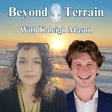
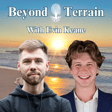



![DNA Doesn't Exist & Genomic Nonsense with Dr. Jerneja Tomsic [Part 2] image](https://media.zencastr.com/cdn-cgi/image/width=112,quality=85/image-files/652933f3a749dc383eb375de/ce5a5fd9-98c9-44fe-9b4b-3d0cd5abcf29.png)


